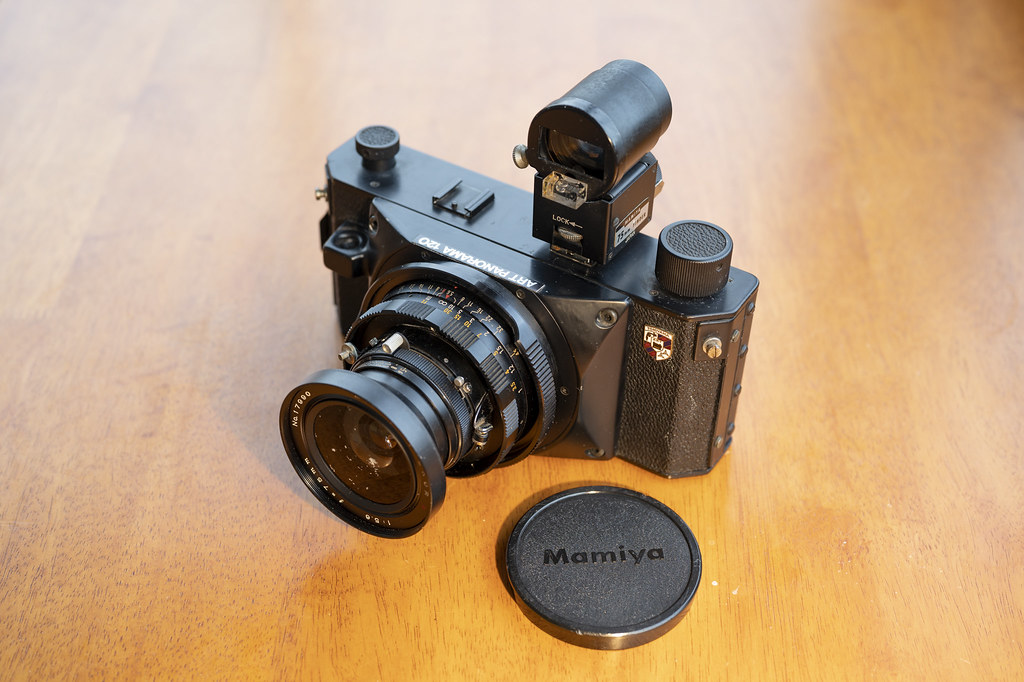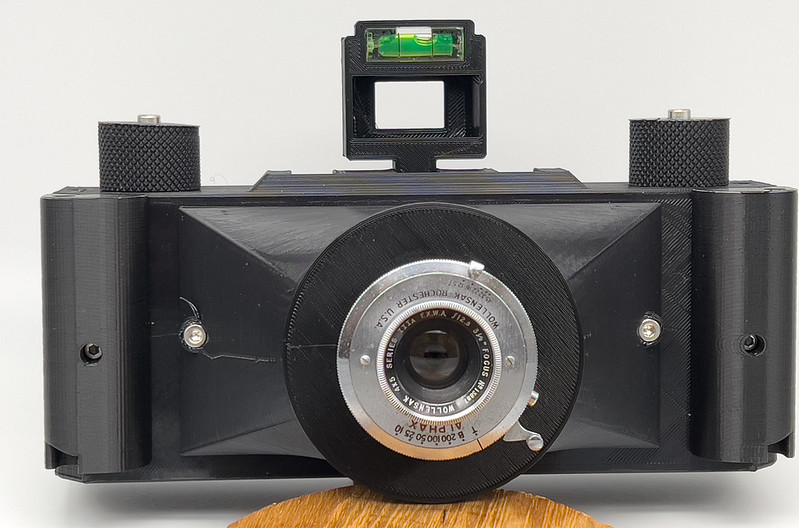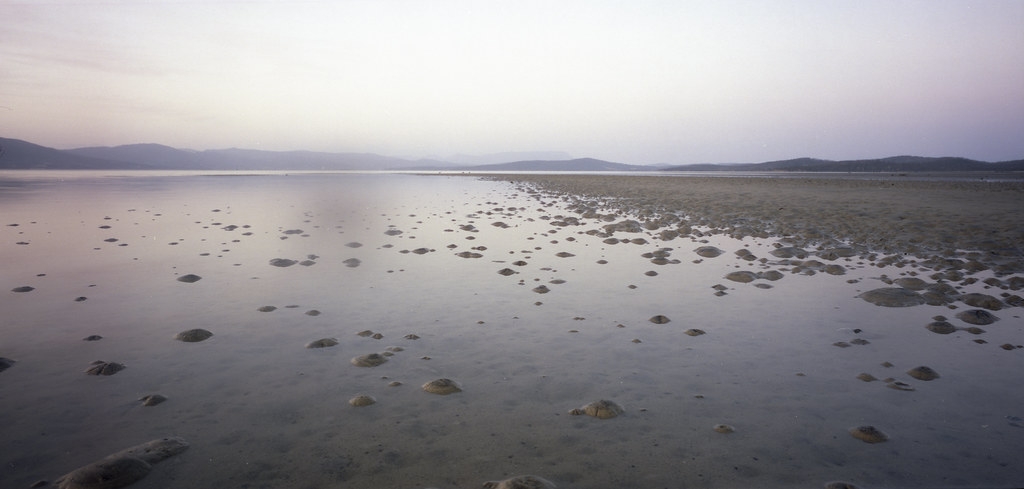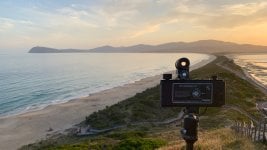nickthetasmaniac
Mentor
Hi all, I was recently lucky enough to be gifted a Tomiyama Art Panorama 120 by a rather eccentric family member.
This is a medium format panorama camera that shoots a 120x60mm (2:1) negative. It uses the Mamiya Universal mount and my version came with the Mamiya-Sekor P 75/f5.6.
Try as I might, I've been able to find very little info about these cameras. There's a bit about the (slightly) more common 170 and 240 versions, but almost nothing on the 120.
I'm currently running through a test roll via trial and error, but would love to hear from anyone with experience of these beasts!
I'm especially curious if anyone can confirm whether the Mamiya 127/f4.7 covers a 120mm negative?

Tomiyama Art Panorama 120 by Nick Clark, on Flickr
This is a medium format panorama camera that shoots a 120x60mm (2:1) negative. It uses the Mamiya Universal mount and my version came with the Mamiya-Sekor P 75/f5.6.
Try as I might, I've been able to find very little info about these cameras. There's a bit about the (slightly) more common 170 and 240 versions, but almost nothing on the 120.
I'm currently running through a test roll via trial and error, but would love to hear from anyone with experience of these beasts!
I'm especially curious if anyone can confirm whether the Mamiya 127/f4.7 covers a 120mm negative?

Tomiyama Art Panorama 120 by Nick Clark, on Flickr
Maybe you have already seen this thread Nick? But just in case.
https://www.photo.net/forums/topic/11238-mamiya-press-75mm-127mm-coverage/
Congratulations, and happy new year too.
Cheers,
Brett
https://www.photo.net/forums/topic/11238-mamiya-press-75mm-127mm-coverage/
Congratulations, and happy new year too.
Cheers,
Brett
Retro-Grouch
Well-known
Very nice! Can I be adopted into your family, ideally in time for my birthday?
Out to Lunch
Menteur
There are a few Google links to this particular model. Also, Lomography.com dedicates a page to it. Cheers, OtL
nickthetasmaniac
Mentor
Maybe you have already seen this thread Nick? But just in case.
https://www.photo.net/forums/topic/1...27mm-coverage/
Congratulations, and happy new year too.
Cheers,
Brett
Thanks Brett, yes I saw that one. Looks like the 127mm would be suitable. I also found an old KameraStore listing for a 120 with both the 75mm and 127mm. Looks like the viewfinder solution for the 127mm is just a mask over the 75mm external finder. Happy new year to you too!
There are a few Google links to this particular model. Also, Lomography.com dedicates a page to it. Cheers, OtL
I did see the Lomo gallery, although the colour shots look like they were taken with a pinhole? I haven't found many other useful google links. Camera-Wiki has a short section on the 120 on their Tomiyama page. The rest of the links I found seem to be auctions or referring to the 170/240 models.
Out to Lunch
Menteur
Since the camera is very basic would there be substantial differences in operation between the 120 and 170? I doubt it. An intriguing project, please keep us abreast. Cheers, OtL
raydm6
Yay! Cameras! 🙈🙉🙊┌( ಠ_ಠ)┘ [◉"]
Very cool looking rig. Congratulations on the acquisition. Looking forward to seeing the results.
nickthetasmaniac
Mentor
Since the camera is very basic would there be substantial differences in operation between the 120 and 170? I doubt it. An intriguing project, please keep us abreast. Cheers, OtL
Yes and no (from what I can gather). The 170 and 240 are mechanically a bit different from the 120. They use a lens board for focussing and have removable backs with dark slides and ground glass screens for critical focus. I think I've got the 120 operation sussed, just hoping I'm not missing something silly!
Nick,Yes and no (from what I can gather). The 170 and 240 are mechanically a bit different from the 120. They use a lens board for focussing and have removable backs with dark slides and ground glass screens for critical focus. I think I've got the 120 operation sussed, just hoping I'm not missing something silly!
If you need a suitably sized ground glass for verifying its focus, these are very easy and cheap to make. I needed some more anti newton ring glass early this year to scan my 70mm film strips (I already had a couple of pieces but suffice to say these have been stored in a *very safe* place, because I cannot find them anywhere). So I got my local glazier to cut me four strips to size for a buck each. I took them home and lapped each pair with cerium oxide until I had the opacity I wanted. Get a couple of pieces cut to the required size of your film rails, bring them over and I'll show you how to lap them. Super easy and takes 5–20 minutes, depending on how diffuse you want them. Have plenty of cerium. You might, possibly find one useful for masking off a finder more precisely, to suit the precise field of view you actually get through various lenses...
Cheers,
Brett
nickthetasmaniac
Mentor
nickthetasmaniac
Mentor
Hi Brett, unfortunately the 120 is the only one that doesn’t have a removable back/dark slide, so there’s no way to fit a ground glass screen while film is loaded.Nick,
If you need a suitably sized ground glass for verifying its focus, these are very easy and cheap to make. I needed some more anti newton ring glass early this year to scan my 70mm film strips (I already had a couple of pieces but suffice to say these have been stored in a *very safe* place, because I cannot find them anywhere). So I got my local glazier to cut me four strips to size for a buck each. I took them home and lapped each pair with cerium oxide until I had the opacity I wanted. Get a couple of pieces cut to the required size of your film rails, bring them over and I'll show you how to lap them. Super easy and takes 5–20 minutes, depending on how diffuse you want them. Have plenty of cerium. You might, possibly find one useful for masking off a finder more precisely, to suit the precise field of view you actually get through various lenses...
Cheers,
Brett
Very curious about masking off the finder though. The ‘stock’ panorama mask the Tomiyama uses for the Mamiya 75mm finder is pretty vague. I’ve just finished a test roll so it will be interesting to see how accurate it is. I might be looking for a better solution soon.
As an aside, any suggestions to add grid lines to the finder? I’m finding it very tricky to keep horizons level with the clear finder.
shawn
Mentor
You would likely need to open the finder up and add grid lines where the existing framelines are. Anything on the outside won't give a sharp edge.
Looks like it has a bubble level on the finder, I'm suprised they didn't put an opening in the mask at the center point so you could see when the camera is level.
Take a shot from a location that is easy to return to. After you develop the negative go back and compare the negative against the viewfinder so you can see how they differ. With external masks eye position will influence the framing so try and make sure you have your eye centered.
If you have an iPhone the 'Viewfinder' app can be set for custom camera/lens combinations and you should be able to setup 6x12 with a 127mm lens easily. That app is great.
I make 6x12 and 6x17 finders for Krakens. They are glassless, more like a sportsfinders and have somewhat indistinct edges but do work and I prefer them to external masks on an optical finder when the FOV doesn't get too wide.
The finder on this camera:

is for a 90mm 6x12 and you can see the bubble level looking through the finder. I could mock up a version for a 127mm 6x12 camera if you want. It will get you in the ballpark. I could probably put the leg off center to try and compensate for the off center cold shoe on that camera.
Shawn
Looks like it has a bubble level on the finder, I'm suprised they didn't put an opening in the mask at the center point so you could see when the camera is level.
Take a shot from a location that is easy to return to. After you develop the negative go back and compare the negative against the viewfinder so you can see how they differ. With external masks eye position will influence the framing so try and make sure you have your eye centered.
If you have an iPhone the 'Viewfinder' app can be set for custom camera/lens combinations and you should be able to setup 6x12 with a 127mm lens easily. That app is great.
I make 6x12 and 6x17 finders for Krakens. They are glassless, more like a sportsfinders and have somewhat indistinct edges but do work and I prefer them to external masks on an optical finder when the FOV doesn't get too wide.
The finder on this camera:

is for a 90mm 6x12 and you can see the bubble level looking through the finder. I could mock up a version for a 127mm 6x12 camera if you want. It will get you in the ballpark. I could probably put the leg off center to try and compensate for the off center cold shoe on that camera.
Shawn
nickthetasmaniac
Mentor
You would likely need to open the finder up and add grid lines where the existing framelines are. Anything on the outside won't give a sharp edge.
Looks like it has a bubble level on the finder, I'm suprised they didn't put an opening in the mask at the center point so you could see when the camera is level.
Take a shot from a location that is easy to return to. After you develop the negative go back and compare the negative against the viewfinder so you can see how they differ. With external masks eye position will influence the framing so try and make sure you have your eye centered.
If you have an iPhone the 'Viewfinder' app can be set for custom camera/lens combinations and you should be able to setup 6x12 with a 127mm lens easily. That app is great.
I make 6x12 and 6x17 finders for Krakens. They are glassless, more like a sportsfinders and have somewhat indistinct edges but do work and I prefer them to external masks on an optical finder when the FOV doesn't get too wide.
The finder on this camera:

is for a 90mm 6x12 and you can see the bubble level looking through the finder. I could mock up a version for a 127mm 6x12 camera if you want. It will get you in the ballpark. I could probably put the leg off center to try and compensate for the off center cold shoe on that camera.
Shawn
Thanks for the reply, very interesting.
Part of the issue with the 'standard' viewfinder is that the mask is just a rotating bit of metal held over the front of the regular Mamiya VF and fastened with a thumb-screw. The bubble is also attached to the mask, rather than the actual VF. You can see this in the picture in my OP.
Unfortunately, there's nothing to accurately center the mask, so it's basically guesswork whether the framing and level are correct...
nickthetasmaniac
Mentor
A few frames from the test roll of Cinestill 400D. Mostly good, but there's a blemish which I'm yet to diagnose.

Bruny Island by Nick Clark, on Flickr

Bruny Island by Nick Clark, on Flickr

Bruny Island by Nick Clark, on Flickr

Bruny Island by Nick Clark, on Flickr
maryland_fotos
Well-known
Congratulations Nick and thanks for posting samples! Tomiyama's are simple cameras, kind of the poor man's version of the equivalent Linhof ultrawide. I have the 170 and getting those super wide panoramas with it is fun. Carrying it around isn't. The 170 indeed has the ground glass you can use to focus and frame before you put the film roll in. I did that the first time around and since then I have just depended on the top viewfinder (which seems reasonable) for the framing, and for panoramic scenes just have it set to infinity and a small enough aperture. I am going to presume your Mamiya lens covers the 6X12 view. The 170 came with the Nikkor 90 f8.
nickthetasmaniac
Mentor
Yep, the Mamiya-Sekor P 75/5.6 was the 'kit lens' for the 120, and seems to cover 6x12 with reasonable quality in the corners. All of my test shots were stopped down a fair bit, so not sure how well it would perform wide-open.Congratulations Nick and thanks for posting samples! Tomiyama's are simple cameras, kind of the poor man's version of the equivalent Linhof ultrawide. I have the 170 and getting those super wide panoramas with it is fun. Carrying it around isn't. The 170 indeed has the ground glass you can use to focus and frame before you put the film roll in. I did that the first time around and since then I have just depended on the top viewfinder (which seems reasonable) for the framing, and for panoramic scenes just have it set to infinity and a small enough aperture. I am going to presume your Mamiya lens covers the 6X12 view. The 170 came with the Nikkor 90 f8.
As far as I can tell, the 127/f4.7 is the only other Mamiya Universal lens that can be used on 6x12 without serious fall-off and quality loss.
Share:
-
This site uses cookies to help personalise content, tailor your experience and to keep you logged in if you register.
By continuing to use this site, you are consenting to our use of cookies.


